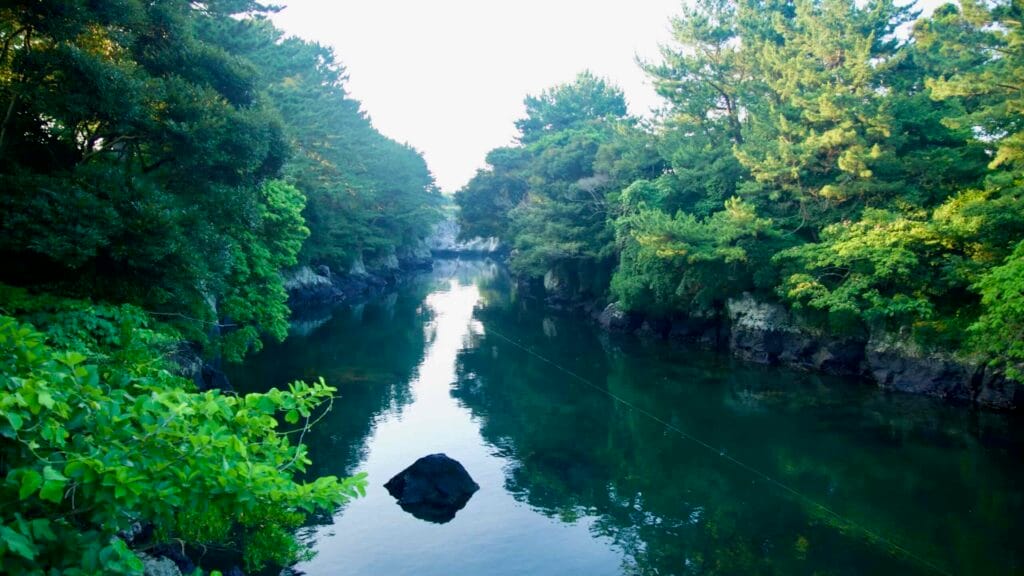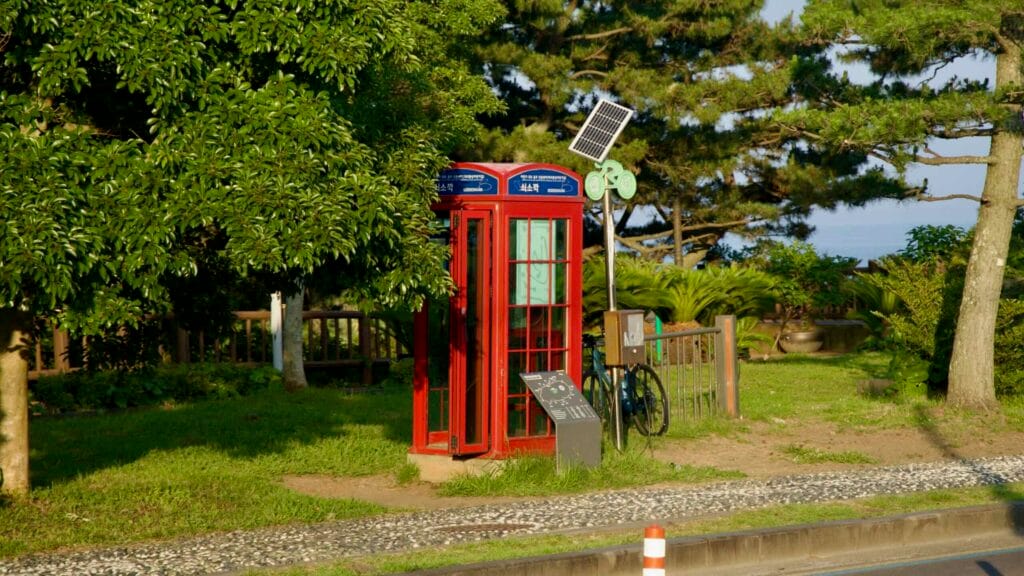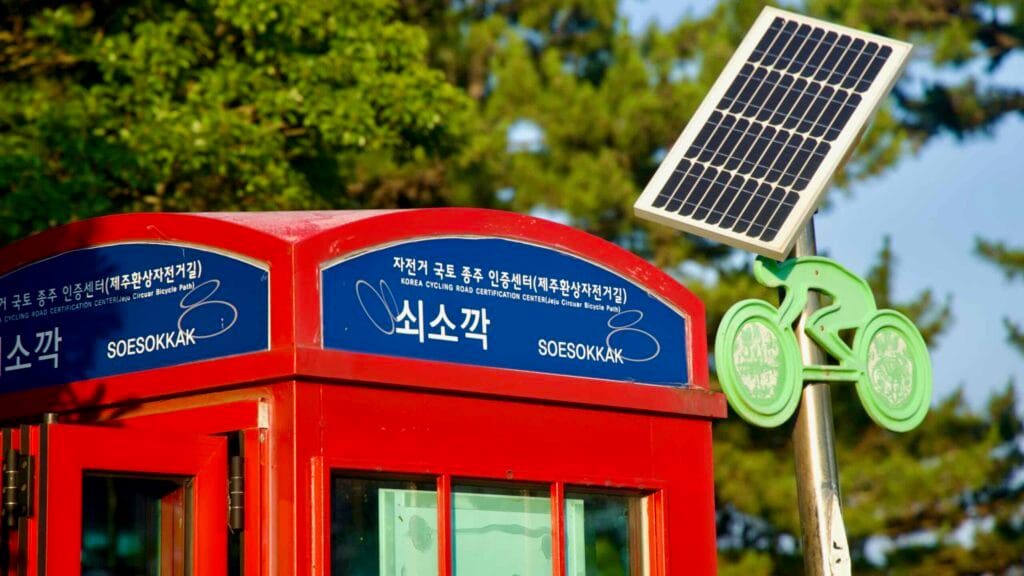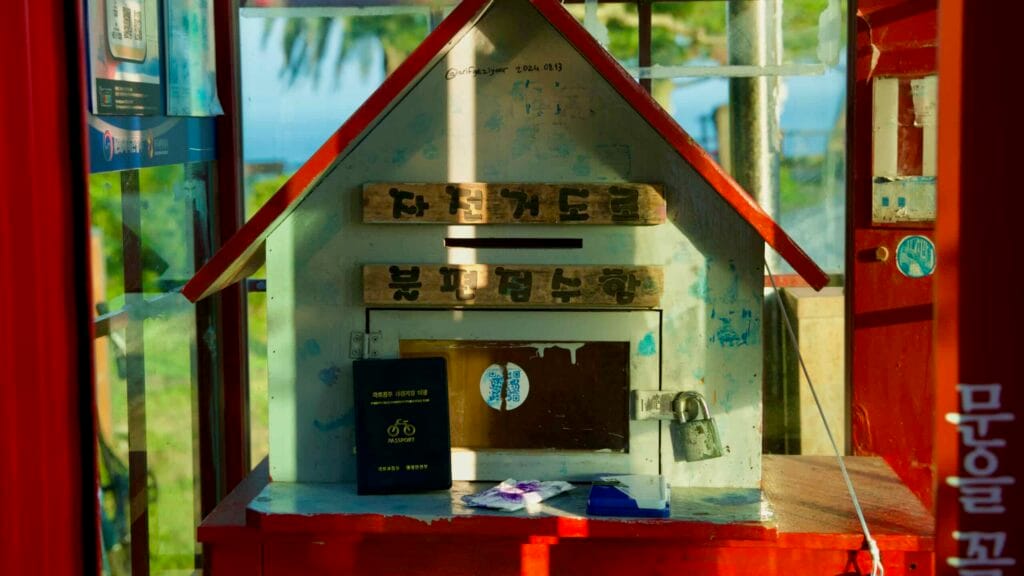Soesokkak Estuary
Soesokkak Estuary (쇠소깍; map) is a short lava-cut gorge sitting at the mouth of Hyeodon Stream (Hyodoncheon) in Seogwipo City, Jeju Island.
The estuary marks the meeting point of fresh and saltwater, forming a deep, emerald-green pool surrounded by volcanic rock formations and pine forests. Its landscape makes it a must-visit spot for nature lovers and adventurers alike.
The estuary’s name was once called “Soedun” because the pool and banks resembled a cow at rest. Over time the name settled as “Soesokkak,” literally “cow-pool-end” (soe = cow, so = pool, kkak = end).
The Soesokkak Certification Center (쇠소깍 인증센터; map) nearby makes it a key stop on the Jeju Fantasy Bike Path.
Features
The water is brackish and very clear, with columnar joints, undercut ledges, and small springs (용천수) along the banks. To the west is Hahyo Soesokkak Beach (하효쇠소깍해변; map). This point also forms the hand-off between Jeju Olle Route 5 and Route 6 (map).
Traditional flat wooden rafts (teu) run short out-and-back rides on the estuary. Kayaks and canoes also operate on the same reach in calm conditions.
- Operating Hours:
- 9:00 AM to 6:00 PM (summer)
- 9:00 AM to 5:00 PM (winter)
- Paused for weather and high flow.
- Fees:
- Teu: 8,000 won (adults) / 5,000 won (children)
- Traditional Canoe: 20,000 won per boat (maximum 2 adults and 1 child)
A riverside walk and short boardwalks give easy views down into the pool and out toward the coast. From here you can continue west toward Sojeongbang/Jeongbang (정방폭포; map) or east toward Hahyo and Seogwipo’s city edge. Surfaces are mixed: decking, packed soil, and basalt. No lifeguard; rocks get slick after rain.
Each summer a small Soesokkak Festival (쇠소깍 축제) takes place on and around the black-sand shores of Hahyo Soesokkak Beach, with ecology walks on Hyodon Stream, simple contests, and water-safety events. Dates and programs change year to year.
History
Before Soesokkak became a scenic stop, villagers treated the estuary as a sacred spot. During droughts they held giwonje (rain-prayer) rites on the rocks above the pool and observed taboos against throwing stones or playing roughly in the water.
Local histories also record practical uses: when conditions allowed, people blocked the narrow mouth to make small pans for bay salt. Folklore attached to the site includes a well-known tale of star-crossed lovers linked to an upstream pool and a “prayer rock” on the estuary.
On June 30, 2011, the Cultural Heritage Administration designated Soesokkak Scenic Site No. 78 for its representative estuarine landform—brackish pool, great depth, and lava walls at the terminus of Hyodon Stream.
Guide
Soesokkak is open all day with no admission. Public toilets sit by the entrance. You’ll find parking in assigned lots and along the road, which fills quickly on weekends and holidays.
Wear shoes with good grip if you plan to walk on the basalt rocks. When boats are operating, drone use is typically restricted.
From here you can walk to Hahyo’s black-sand shore, pick up Olle Route 6 toward downtown Seogwipo, or continue west toward Sojeongbang and Jeongbang Falls. Cafés and small restaurants cluster along the nearby Hahyo Soesokkak Beach.































